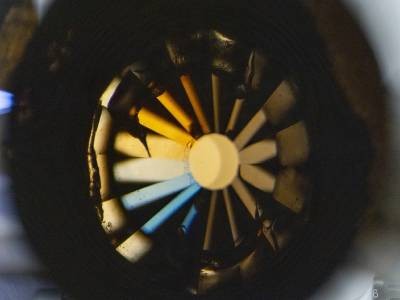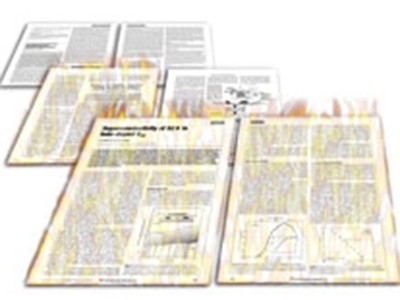Superconductivity has been demonstrated at extremely low temperatures, but it remains elusive at room temperatures.Credit: Brookhaven National Laboratory/SPL
Research misconduct is hugely detrimental to science and to society. Defined as “fabrication, falsification, or plagiarism in proposing, performing, or reviewing research, or in reporting research results” by the US Office of Research Integrity, it violates trust in science and can do great harm to the wider public, scientific institutions and especially co-authors and students who had no part in the wrongdoing. In cases involving public funds, it squanders resources that could have been allocated to other research and it can erode lawmakers’ support for science.
Does the scientific community, as a whole, have appropriate processes for reporting, investigating and communicating about instances of potential misconduct? This question is not new. At Nature, we’re asking it again, after two separate studies that we published were subsequently retracted.
Exclusive: official investigation reveals how superconductivity physicist faked blockbuster results
The studies1,2 were originally published in October 2020 and March 2023. The first was retracted in September 2022 and the second in November 2023. The corresponding author on both papers was Ranga Dias, a physicist studying superconductivity at the University of Rochester in New York, and a recipient of grants from the US National Science Foundation (NSF).
The papers by Dias and his co-authors claimed to report room-temperature superconductivity under extremely high pressures, each in different materials. Room-temperature superconducting materials are highly sought after. They could, for example, transform the efficiency of electricity transmission, from the smallest to the largest application. But high-pressure experiments are difficult and replicating them is complex.
Nature initiated an investigative process that resulted in the 2020 paper being retracted after members of the community told the journal they were troubled by aspects of the data being reported. Nature also initiated an investigation into the 2023 paper. However, this article was retracted at the request of most of Dias’s co-authors while the investigation was still ongoing.
Many details about this case came to light thanks to continued questions from the research community, including during post-publication peer review. Much credit must also go to the persistence of science journalists, including members of Nature’s news team (which is editorially independent of Nature’s journal team) and those from other publications.
What can journal editors, funding organizations and institutions that employ researchers learn from such cases? We have the same goal: producing and reporting rigorous research of the highest possible standard. And we need to learn some collective lessons — including on the exchange of information.
The University of Rochester conducted three inquiries, which are a preliminary step to making a decision about whether to perform a formal investigation into scientific misconduct. The inquiries were completed between January and October 2022. Each concluded that such an investigation was not warranted.
Superconductivity scandal: the inside story of deception in a rising star’s physics lab
Earlier this month, Nature’s news team uncovered a 124-page report on a subsequent confidential investigation, performed at the NSF’s request. In it, a team of reviewers concluded after a ten-month assessment of evidence that it was more likely than not that Dias had committed data fabrication, falsification and plagiarism. The report is dated 8 February 2024, and the determination is regarding the two Nature papers, a 2021 study3 published in Physical Review Letters and a 2022 study4 in Chemical Communications — both of which were also retracted. However, the investigation has not yet officially been made public.
Some researchers have asked why Nature published Dias’s second paper in March 2023, when questions were being asked about the first one. Others have asked why the retraction notices didn’t spell out that there has been misconduct.
It’s important to emphasize that it’s Nature’s editorial policy to consider each submission in its own right. Second, peer review is not designed to identify potential misconduct. The role of a journal in such situations is to correct the scientific literature; it is for the institutions involved to determine whether there has been misconduct, and to do so only after the completion of due process, which involves a systematic evaluation of primary evidence, such as unmodified experimental data.
Access to raw data is fundamental to resolving cases of potential misconduct. It is also something we constantly think about in relation to publishing. Indeed, for certain kinds of data, Nature requires authors to deposit them in external databases before publication. But there must be more the research community — including funders and institutions — can all do to incentivize data sharing.
Another question is whether the matter could have been dealt with more quickly. Nature’s editors have been asking the same question: specifically, could there have been more, or better, communication between journals and institutions once evidence of potential misconduct came to light?
Publish, and be damned…
Last month, the Committee on Publication Ethics (COPE), a non-profit organization that represents editors, publishers and research institutions, updated its guidelines on how publishers and universities could communicate better. The guidelines are full of important advice, including that institutions, not publishers, should perform integrity or misconduct investigations. Investigators require access to primary evidence. As employers and grant-givers, institutions are the appropriate bodies to mandate access to unmodified experimental data, correspondence, notebooks and computers and to interview relevant staff members — all essential parts of an investigation.
But often, journals need to start a process that could lead to retracting a study in the absence of an institutional investigation — or while an investigation, or inquiry, is ongoing5. Are cases such as this an opportunity for journals and institutions to discuss establishing channels through which to exchange information, in the interest of expedited outcomes — as part of due process? Nature’s editors would be willing to play a part in such discussions.
Retractions are part of publishing research, and all journals must be committed to retracting papers after due process is completed. Although a paper can be retracted for many reasons, when the cause is potential misconduct, institutions must conduct thorough investigations.
This case is not yet closed. Both the university and the funder need to formally announce the investigation’s results, and what action they intend to take. They should not delay any more than is necessary. When there is credible evidence of potential scientific misconduct, investigations should not be postponed. There is strength in collaborating to solve a problem, and nothing to be ashamed of in preserving the integrity of the scientific record.




